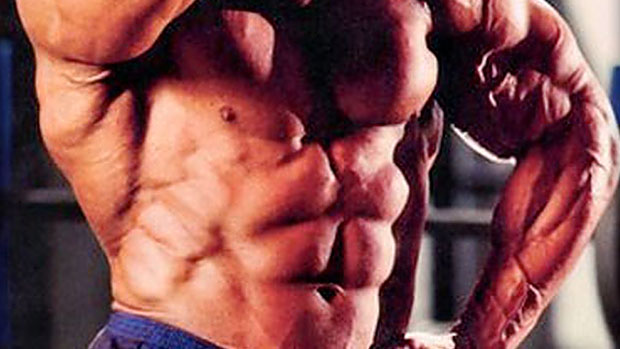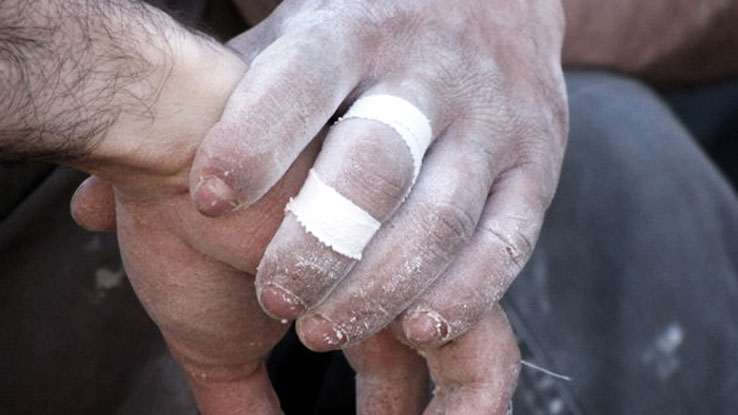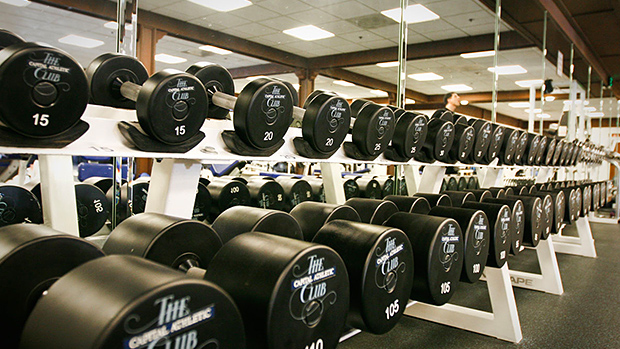Core Training.
God we hate that term.
Unfortunately, we seem to be stuck with it. And along with being stuck with the term, we seem to be stuck with a flawed version of it as just about every trainee makes two outdated choices:
First, he gets down on the floor. Second, he does high reps of crunches, sit-ups, and leg raises.
There's nothing wrong with doing exercises on the floor, if we're talking about planks and other isometric exercises designed to increase endurance and stability. But if you're on the floor to see how many crunches you can knock out, I have to wonder what exactly you're training your body to do.
What you should be doing is training your core to support your body during heavy lifts. No offense to the folks at Inzer, but you were born with a natural weight belt. Train your diaphragm and deep mid-body muscles to generate intra-abdominal pressure, and you'll be able to lift heavier weights without risk of injury.
The best way to do that is to train your core in conjunction with your entire body. The body is an integrated unit, and if you train it as such, you'll take full advantage of your body's potential for growth and performance.
Strike that Pose
Effective core training starts with your posture.
Imagine that the best-looking woman in your gym is watching your every move. (I know it's far-fetched, but work with me.) What do you do in response? You stick out your chest, tighten your waist, and pull back your shoulders. That's the posture you want for every exercise you do, whether we're talking about curls or deadlifts. With that modification alone, 90% of the lifters in an average gym would instantly improve.
But I'm not talking about a beach pose; tightening your waist isn't the same as sucking in your gut. You're trying to increase the rigidity of the entire torso to reduce the compressive forces on your spinal discs while supporting the vertebral column.
If you're not used to bracing your core when you lift, you'll find it exhausting the first few times you try it. Three sets of 10 squats are out of the question — you'll lose intra-abdominal pressure after the first few reps.
The solution is simple enough: Keep the reps low, doing five or fewer per set. Even if you're training with relatively light weights (lower than 80% of your one-rep max), you can still get a good workout by increasing the number of sets and/or decreasing the rest intervals. The point is to use the low reps as practice for staying tight, with the goal of working your way up to higher reps or loads closer to your 1RM.
While you're practicing abdominal bracing in your regular workouts, you can improve the strength, endurance, and stability of your core with targeting training, using the following techniques.
Isometrics
The plank is a great exercise that few lifters utilize as often as they should. They're more tedious than crunches and bicycles, with less of a feeling of instant reward. But they're exponentially more beneficial for core strength and lower-back health.
But, as I said, they get old fast. That's why we need alternatives that can challenge your mid-body muscles and improve your big lifts without making you feel as if you're enduring enhanced interrogation techniques. I like to use isometric versions of exercises that require a lot of intra-abdominal pressure, including these two:
Front-loaded Bulgarian split squat
Stand with good posture (striking the pose) two to three feet in front of a bench holding a plate, dumbbell, or kettlebell against your chest. Place your left foot on the bench behind you so the laces of your left shoe are on the bench. Brace your core. Lower your body slowly until your right knee is bent 90 degrees, and your left knee is an inch or two from touching the floor.
Hold as long as you can, then end the set when you start to lose intra-abdominal pressure. Rest as long as necessary, then switch legs and hold for as long as you held with the first leg.
Front squat
Set up as you normally would for a front squat, with perfect pose-striking posture. Once you have control of the weight, and the bar is resting firmly on your upper chest, extend your arms out in front of you, parallel to the floor.
Your arms must remain parallel for two kind of obvious reasons that are still worth mentioning: First, if they drop below parallel, the bar will roll down your arms and crash to the floor. Second, if you hold them above parallel, the bar will go from a comfortable resting position on your upper chest to the middle of your neck. Nobody needs to do a barbell choke-out in the middle of an exercise.
Hold for three sets of maximum duration, defined by the length of time you can maintain an abdominal brace with perfect posture. Rest as long as needed between sets.
Isometric/Dynamic Hybrid
This type of exercise adds an isometric hold to a dynamic exercise. It's a great way to sneak in a little extra core training. It's most effective when used sparingly. You don't want to overload your workouts with these types of movements though, since the isometric component will probably limit your ability to generate force and recruit motor units with the dynamic part of the exercise.
So, in the case of the following exercise, you wouldn't want to make it the primary or only chest-building movement in your weekly program. You also wouldn't consider it your primary core exercise. But it's a terrific complementary exercise, allowing you to accomplish two goals at the same time.
Dumbbell floor press with legs elevated
The name describes the exercise: You'll do a floor press using dumbbells with your legs raised about six inches off the floor.
Unilateral Work
It's one thing to brace your core in an exercise that's specifically designed for core bracing, like the plank. It's another, somewhat harder thing to challenge your core when during isometric versions of exercises that are normally done dynamically, like the split and front squats I just described.
You can also challenge your core by doing unilateral versions of dynamic exercises that are typically done with both arms or legs. I like these exercises because they allow you to go heavy and give the targeted muscles a true hypertrophy stimulus, while at the same time forcing you to employ abdominal bracing. As such, you build muscle and increase strength, while the unbalanced load helps improve your coordination and core stability.
Some of my favorites:
Dumbbell single-arm bent-over row
This should look like a standard barbell bent-over row in terms of your posture. The only difference is that you're lifting a dumbbell with one arm at a time. Hold the weight in one hand with your arm straight, and bend forward at the hips until your torso is almost parallel to the floor, with your back flat. Pull the dumbbell to your upper ribcage.
Do all your reps with that arm, then switch arms and repeat.
Maintain the abdominal brace throughout the movement, and keep your reps smooth and controlled.
Dumbbell single-arm bench press
You can do this on a flat or incline bench. It's exactly the same as a dumbbell bench press, except with one dumbbell at a time. Again, maintain the abdominal brace throughout the movement, and keep your reps at a steady tempo, such as 3-0-3-0.
Unilateral hanging leg raise
Hang from a pull-up bar with a medium grip. While keeping your legs straight and your torso motionless, lift one leg until it's parallel to the floor, and then lower it. Do all your reps with that leg before repeating the same number of reps with the other leg. Work at a deliberate pace, focusing on posture and form.
Suitcase deadlift
You can do this with an Olympic barbell, EZ-curl bar, dumbbell, kettlebell, or sandbag.
If you're starting with your left side, stand with your legs shoulder-width apart and your left foot alongside the weight. Squat down as you would in a regular deadlift, with your chest up, back flat, and knees bent. Grab the weight with your left hand, brace your core, square your shoulders, and pull the weight up until you're standing straight. Lower the weight the same way until it touches the floor. Finish all your reps with that side, rest 30 seconds, and repeat the set with the weight on your opposite side.
The goal is to make the exercise look exactly like a standard deadlift, only with the weight at one side instead of the front. But you can modify that by extending your non-working arm to the side, which should improve your balance if you find yourself leaning toward the weight.
If you struggle with the range of motion, you can start the weight higher by stacking some 45-pound plates on the floor as a platform.
Modified renegade row
If you were doing a standard renegade row, you'd have two dumbbells on the floor, grab them with your body in a push-up position, and then lift one at a time to your side as you brace your body to prevent excessive twisting. This version allows you to do more reps with a heavier weight, but it's still challenging enough to make you hold your sides in pain when you're done.
Start with a bench or sturdy box, whatever allows you to get into push-up position with your hands on the bench or box, your toes on the floor, and your body at a 45-degree angle to the floor, more or less. (The higher the surface, the easier it will be.) You want your body in a straight line from neck to ankles.
Take one hand off the bench and grab a dumbbell. Starting with your arm straight, row the dumbbell to the side of your ribcage, lower it, and finish all your reps on that side. Switch arms and repeat the set. Keep the pace deliberate, focusing on your posture and core stability.
Overhead Lifts
Anyone who does overhead squats regularly and successfully knows how important it is to keep a tight core. But in my experience it's rare to see a lifter — even if he's a relatively advanced T Nation reader — who does this exercise correctly. Obviously, a lack of core stability is a deal-breaker, but the most common problem I see is a lack of flexibility and mobility. If you're too tight in the ankles, hips, or thoracic spine, you won't be able to hold the weight with straight arms directly over the middle of your feet throughout the range of motion.
That's why I like to use the overhead reverse lunge instead. You get the benefit of the exercise — improved core stability — without being penalized for a lack of mobility.
The exercise is easy to describe: Hold a weight plate with both hands directly overhead. (You can also use a barbell or pair of dumbbells.) Step back with one leg into a reverse lunge. It's important to retract your shoulder blades as you step back; that prevents your upper body from tilting forward.
Do all your reps with that leg, then repeat the set with the other.
Partial Turkish get-up
The full Turkish get-up has so many moving parts that it's rarely performed correctly. This partial version lets you focus on the first parts of the exercise. You perfect your form while still presenting a tremendous challenge to your core.
Lie on your back with a dumbbell in your right hand and your right arm locked and stable, as it would be at the top of a bench press. Your right knee should be bent with your toe pointed away from your body slightly and your heel kept close to your butt. You want your entire upper body pressed against the floor, with your shoulder blades pulled together. (A common error I see is the shoulder of the working arm raised off the floor in the beginning of the exercise.)
Your left leg is straight, with your heel pinned to the ground, while your left hand rests on your abdomen.
Start the movement by reaching out to the side with your left arm. Push through your left forearm and right heel to raise your head and upper body off the floor, with your right arm remaining straight and reaching toward the ceiling.
Slowly lower yourself to the starting position. Finish the set on that side, then switch and repeat.
The Program
This is a very simple core-strengthening program I use with many of my clients. Do each workout once a week, as a complement to your normal workouts.
Each workout begins with an isometric movement. Next come a pair of strength movements, which you'll do as a superset. (They're shown as B1 and B2 in the charts.) Then you'll do two core-specific exercises as straight sets.
Workout 1 (Monday)
| Exercise | Sets | Reps | Rest | |
| A | Isometric front squat | 3 | ALAP | ALAN |
| B1 | Dumbbell floor press with legs elevated | 3 | 12 | 1 min. |
| B2 | Modified renegade row | 3 | 10 | 1 min. |
| C | Suitcase deadlift | 4 | 6 | 30 sec./side |
| D | Partial Turkish get-up | 3 | 5 | 30 sec./side |
ALAP - means as long as possible.
ALAN - is "as long as necessary.
Workout 2 (Thursday)
| Exercise | Sets | Reps | Rest | |
| A | Isometric Bulgarian split squat | 3 | ALAP | ALAN |
| B1 | Dumbbell single-arm bench press | 3 | 6 | 1 min. |
| B2 | Dumbbell single-arm bent-over row | 3 | 8 | 1 min. |
| C | Overhead reverse lunge | 4 | 6 | 30 sec./side |
| D | Unilateral hanging leg raise | 3 | 5 | 30 sec./side |
The overall goal is to increase total-body awareness and improve your work capacity. After a couple of weeks, you should notice a big difference in your ability to perform the normal, bilateral versions of these exercises.
Oh, and while you're at it, help us come up with a new phrase for "core training, will ya'?




